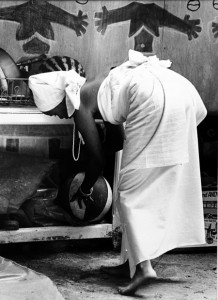During his forty-year photographic career, William Anderson documented the everyday lives of impoverished African Americans in the rural South. His pictures reveal their endurance, dignity and humanity in the face of great hardships. Anderson’s photographs look beyond the wretched conditions of poverty to encompass a sense of community, laughter, and even triumph, without erasing or negating the destitution of the poor.
In Woman in White, taken in 1976, the subject bends over with her back to the viewer while holding a ball on a shelf. The simplicity of her dress, necklace and headscarf balance the varied objects of her surroundings — including a mural of female figures, a rack full of dishes, and a shelf where the ball is stored. The photograph raises questions about how poverty affects the separation between the public and the private. The dish rack signifies the private, domestic sphere, leaving the viewer to wonder why this woman’s dishes are washed outdoors, rather than inside her home. Is this her personal choice, or simply a matter of necessity? The mural in the background also prompts a closer look. What is the significance of the partially nude female forms? How do these figures relate to the woman in the foreground?
William Anderson was born in Selma, Alabama during the Great Depression. Though best known for documenting the African American experience in the South, Anderson began his career as a sculptor. He studied sculpture at the Instituto Allende in San Miguel, Mexico and received his M.F.A. in 1968. Disappointed with the way that other people photographed his sculptures, Anderson began taking pictures of his own artwork. This decision marked the beginning of a significant transition in his career from a little known sculptor to a critically acclaimed photographer.
His photography has won national awards and is included in such prestigious collections as the National Gallery of Art in Washington, D.C., The J. Paul Getty Museum in Los Angeles, the Yale University Art Gallery in New Haven, Connecticut, and the High Museum of Art in Atlanta. Anderson was a professor at Morehouse University for many years and served as chair of the art department. He retired in 2007 to pursue his art full time.
References
- Buchanan, Shonda. “Rural Symphonies in Black and White: The Photography of William Anderson, Jr.” International Review of African American Art 22 no 2 (2008).
Written by Aleedra Price (PO ’10), Getty MUI Summer Intern 2010


